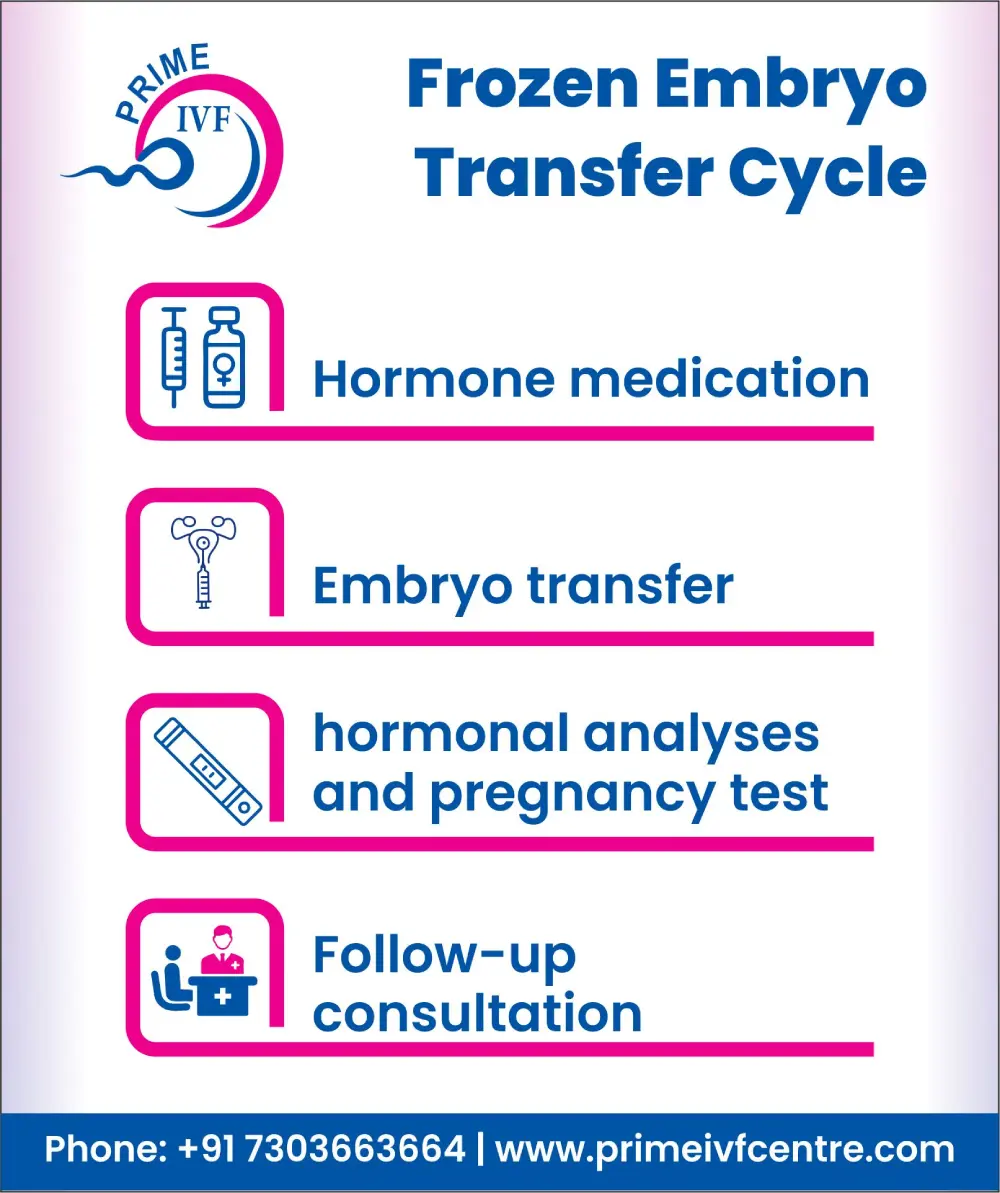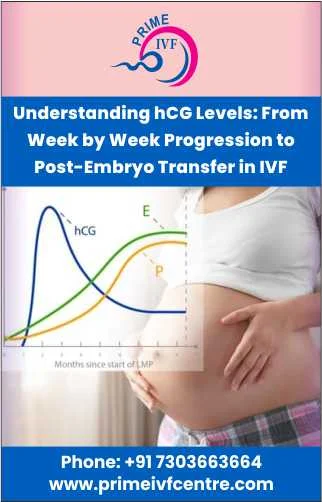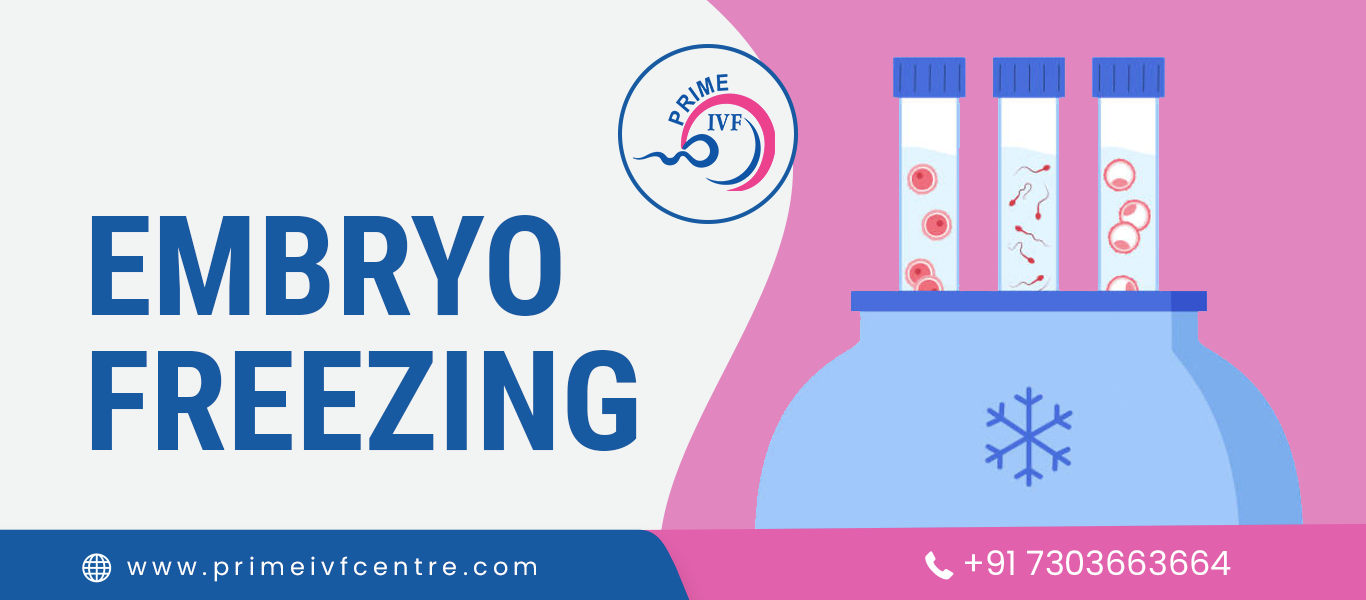Frozen Embryo Transfer Process Step By Step

- 29 Nov, 2022
- IVF and Infertility
- infertility
- Medically Reviewed By:
 Dr. Nishi Singh
Dr. Nishi Singh - Author: Prime IVF Centre
The advancements in the medical field are quite remarkable, and they have been proven a boon to our society in many ways. Medicine aims to provide health and healing. Keeping this in mind, continuous research and hard work have given rise to one of the most helpful procedures and treatments: the Frozen Embryo Transfer process(FET). Of course, you have heard this name which is why you are here, to understand its meaning and the steps of the procedure of frozen embryo transfer well.
Who are the eligible candidates?
Females who are unable to conceive due to irregular cycles, ovulation problems, and lifestyle concerns are often advised for treatments like IVF and FET. In IVF, every embryo is considered a little blessing. That is why we want to save all remaining embryos from an IVF cycle, as they can be necessary for the future.
How is ivf followed by the fet procedure?
The IVF procedure is a strenuous and lengthy treatment that may comprise several attempts for its successful outcome for one live-born infant. As the IVF process requires hormonal stimulation to enhance the growth of multiple ovary eggs which are then fertilized leading to multiple embryos at the same time. The remaining embryos left after the first attempt of Embryo Transfer (ET) are cryopreserved, which is the process of cooling and storing cells, tissues, and even organs at a freezing temperature to save them for future use if the first embryo transfer attempt is not successful or the patient plans for a second child.
What is fet - frozen embryo transfer?
The very popular procedure, the Frozen Embryo Transfer (FET), is a method used in IVF that permits cryopreservation of embryos that were formed earlier with the IVF cycle. These frozen embryos are to be later unfrozen and transferred into a woman's uterus. The incidence rate of pregnancies through FET is relatively equivalent to that of a biological one. Now the question arises why should you opt for the FET ? So here are your answers.
Why Should You Choose Frozen Embryo Transfer?
Females suffering from certain diseases or conditions and females with different lifestyle concerns are advised to opt for a FET to help them conceive.
The following are the benefits of FET
Extra Embryos for future
Transferring more than one embryo at a time produced by the IVF cycle is not considered safe. Such transfers can result in multiple pregnancies, like triplets or quadruplets.
To curtail such risk, gynecologists often prefer elective single embryo transfer. This method leaves chances for the remaining embryo for cryopreservation.
If the patient desires another child through IVF
Suppose the patient wants to conceive another child after the first successful IVF. In that case, she can have another one through FET of the embryo, which was cryopreserved after the first IVF transfer. The cryopreserved embryos can be kept frozen for a considerable time.
Used for genetic screening
The Preimplantation Genetic Diagnosis (PGD) and Preimplantation Genetic Screening (PGS) are promoted diagnostic techniques that help to screen embryos for any particular genetic defects. These technologies are most likely used after three or five days post -fertilization through biopsy.
Females with OHSS
Studies have revealed that in rare cases, the use of fertility drugs can lead to life threatening complications such as Ovarian Hyperstimulation Syndrome(OHSS) which may even cause death. During this complication the embryo transferred is postponed till the condition of the female patient improves and the embryos are frozen for future use in getting pregnant by FET.
What Are the Steps of Frozen Embryo Transfer?
The frozen embryos are transferred in the uterus on a particular day of the menstrual cycle. This particular day is named the "implantation window," which symbolizes the day when the uterus is considered the most receptive to the embryo.

Two types of strategies are used for FET
Before proceeding with the FET procedure, the patient is advised to undergo general examinations, sonography of pelvic scan to recognize the thickness of the endometrial lining and sometimes hysteroscopy.
The steps involved in FET with hormone replacement include:
FET Cycle
- Hormone medication
- Embryo transfer
- hormonal analyses and pregnancy test
- Follow-up consultation
Step 1 - Hormone Replacement Cycles
Estrogen Therapy
Your gynecologist will start with estrogen supplements after completing basic examinations to enhance the growth and increase the endometrium's thickness. After achieving the expected thickness of the endometrium lining, progesterone is now introduced, and a particular date is decided for the FET procedure. The technique is also in conjunction with suppressive injections named down-regulation, which can pioneer on the 21st day of the last cycle.
Natural cycles
During the biological cycle of FET, no hormonal supplements are dispensed. The doctor tracks the biological process of ovulation. The ovulation day is then affirmed by obtaining various scans and blood and urine tests. After completing the tests, the embryo transfer is scheduled into the implantation window. On the day of the FET procedure, the embryo is thawed, checked for its quality, and then transferred into the uterus.
Step 2 - Embryo Transfer
Usually, on the third to the fifth day of progesterone therapy, the embryo is transferred. As for the biological cycle of ovulation, the embryo is transferred to the uterus in the morning on the scheduled day of FET. Explore: After Embryo Transfer Day by Day Symptoms.
Step 3 - Hormonal analysis - Pregnancy Test
After 12-14 days of embryo transfer, the serum pregnancy test is usually performed. If the pregnancy results come positive, the serum progesterone may also be measured. And in case the test comes negative, the hormone therapy is then discontinued, and the menstrual cycle arrives within a few days.
Step 4 - Follow-up Consultation
After the pregnancy test comes positive, the gynecologists will advise performing the vaginal sonogram after three weeks. At this stage, the sonogram can detect the number of embryos as well as the heartbeat of the fetus. The risk of miscarriage after achieving a developmental milestone is low. If the procedure of FET is unsuccessful, the patient should consult their respective doctors.
Costs of Frozen embryo transfer
The cost of FET should be discussed with your doctor while discussing the process and its outcomes. The FET procedure comprises several types of fees correlated with the FET treatment.
The average cost of the FET procedure is 70,000 to 1,25,000 INR.
The average fee comprises monitoring, hormonal support, and the costs related to the transfer process itself. A biological cycle costs a little less because it does not impose fertility drugs. However, the expenditures of the preliminary IVF treatment, the first cryopreservation of the embryos, and any storage fees are not incorporated in the rate.
For how long can the embryos be cryopreserved?
The studies have disclosed that the embryos can technically be frozen or cryopreserved for years. The studies have shown that the quality of the embryo does not disintegrate over time.
What are the success rates following frozen embryo transfer?
The successful prevalence of frozen embryo transfer depends on varied assets, such as
- Age of women
- Period of infertility
- Quality of the frozen embryos
- The day of the freezing (days 3-5)
- The thickness of the endometrial lining etc.
The success rate of the FET procedure is about 50-60% per transfer. It is evaluated that the child born with FET tends to have more weight at the time of birth and with overall good health.
Why is Prime IVF the best for IVF Treatment?
We are offering one of the facilities and technologies for FET and other reproductive treatments. We have a high success rate of the FET procedures, done by certified IVF doctors and embryologists who constantly assure of providing the best clinical facilities to our patients at affordable charges.













